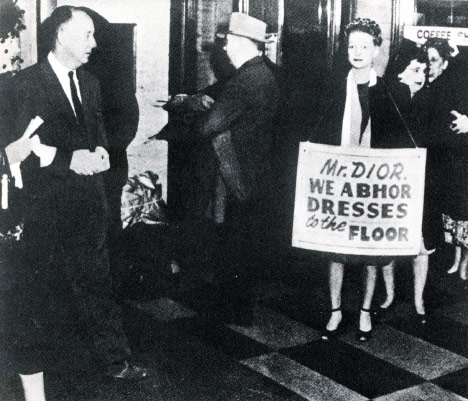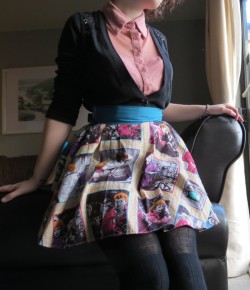The main reason I became interested in fashion and its history is because there is so much more to it than most people understand.
There are reasons behind every design and each reflects the society at the time. It has affects on the public in ways many would not expect.
Today I’ve decided to take a look at my favourite collection, The New Look and the controversies it stirred during the 1940s.
The collection took the world by storm as Christian Dior revolutionized women’s fashion.
When Dior began a fashion house with Marcel Boussac in December 1946, they created voluptious designs, bringing back the S shape silhouette with longer skirts and cinched-in waists.

Dior created the “new look” in 1947, which meant longer skirts and cinched-in waists.
Photo courtesy of the Dreamstress http://thedreamstress.com
Originally the look was known as “Corolle” meaning circlet of flower petals in French.
It was coined the “New Look” by editor-in-chief of Harper Bazaar.
“I have designed flower women,” said Dior on his collection.
Although the designs were highly controversial at the time, it put Paris back on the map as a fashion capital. New York and London had recently rivalled for the top spot, making their own claim for fame in the fashion world during the war.

Dior’s New Look meant fuller skirts, particularly for evening wear. Photo courtesy of Diorable Style.
Dior’s designs replaced padded shoulders, boxy lines, and short skirt of the war time with softer, fuller and more feminine silhouettes.
Because clothing during the war were not allowed to exceed a particular length due to a conservation of material, women were use to wearing short straight-cut outfits while taking over men’s work as they went off to war. Clothes had to be practical.

Fashion during the second World War meant straight cut, almost uniform-style dresses. Courtesy of Sydney Barnett Pinterest. http://www.pinterest.com/sydmb/ch16-the-20s-30s-and-world-war-ii/
When Dior’s designs came to the spotlight, it created a backlash among people across the globe.
A woman named Louise Horn from Georgia, found her new skirt caught in an automatic bus door and was dragged for a block before the bus stopped. She then enlisted more than 1,200 women to sign an anti-Dior petition which led to the protest group Little Below the Knees Club.
In an interview with Newsweek, one protester said, “Long skirts are dangerous. With today’s speed, you can’t even catch a street car in a long skirt. And how can you drive an auto?”

Protest groups multiplied due to Dior’s new fashion who felt the look was impractical.
Photo courtesy of CassieStephens.blogspot.ca
Men also led a group of their own called, The League of Broke Husbands, who protested the exorbitant bills their wives would leave them following the new fashion, due to the decadent amount of material needed.
Celebrities protested as well including designer Coco Chanel and model, Bobbie Woodward who said, “whoever dreamed up this fall’s gruesome styles have been reading too many historical novels.”
However, the fashion was eventually accepted by the general public and similar looks were inspired by Dior’s designs in the 1950’s.
